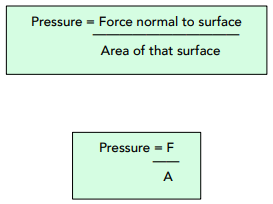Fluid Pressures Part 1 (GCSE Physics)
Fluid Pressures Part 1
Fluids
- Fluids can be liquids or gases. This may seem strange, but the definition of a fluid is this:
Fluids do not have a definite shape. They take on the shape of the container.
- Since both a liquid and a gas can take on the shape of a container, they are called fluids.
Pressure in Fluids
- Fluids consist of moving particles. The particles that make up a fluid can move around. Due to this movement, the particles will collide with each other and the sides of the container.
- Forces are exerted on sides of the container. As the particles collide, the sides of the container will experience a force. These forces will be normal or perpendicular (at right angles) to the sides of the container.
- The forces in the container will exert a pressure. The forces produced by the particles will exert a pressure on the sides of the container. The definition of pressure is as follows:
Pressure is the force per unit area.
- Each particle exerts a force on the sides of the container. This means that they are all exerting a force per unit area and hence they are exerting a pressure.
- The pressure is due to the fluid and atmospheric pressure. An object in a fluid will experience an additional pressure to atmospheric pressure.
Calculating Pressure in Fluids
We have already seen that fluids in a container can exert a pressure. Now, we will discuss how to calculate a value for pressure in a fluid.
Formula for Pressure

Where:
- pressure, p, in pascals, Pa
- force, F, in newtons, N
- area, A, in metres squared, m²
Question: James is filling up his empty water bottle with some water. The weight of the water in the bottle is 18N, and the cross sectional area of the bottom of the bottle is 0.006m2. Calculate the pressure exerted on the bottom of the water bottle, giving its standard unit.
1. Write out the formula.
As with any calculation, the first step is to write out the formula that we are going to use.
P = F /A
2. Substitute in the numbers.
Since we are asked to find the pressure, we should be able to put in values for the force and area. In this question, the force will be the weight of the water and the area will be the bottom of the bottle.
Pressure = force normal to surface / area of that surface
P = F /A
P = 18/0.006
P = 3000
3. State the units.
When we look back at the question, we can see that we are asked to give units with our answer.
P = 3000 Pa





Still got a question? Leave a comment
Leave a comment